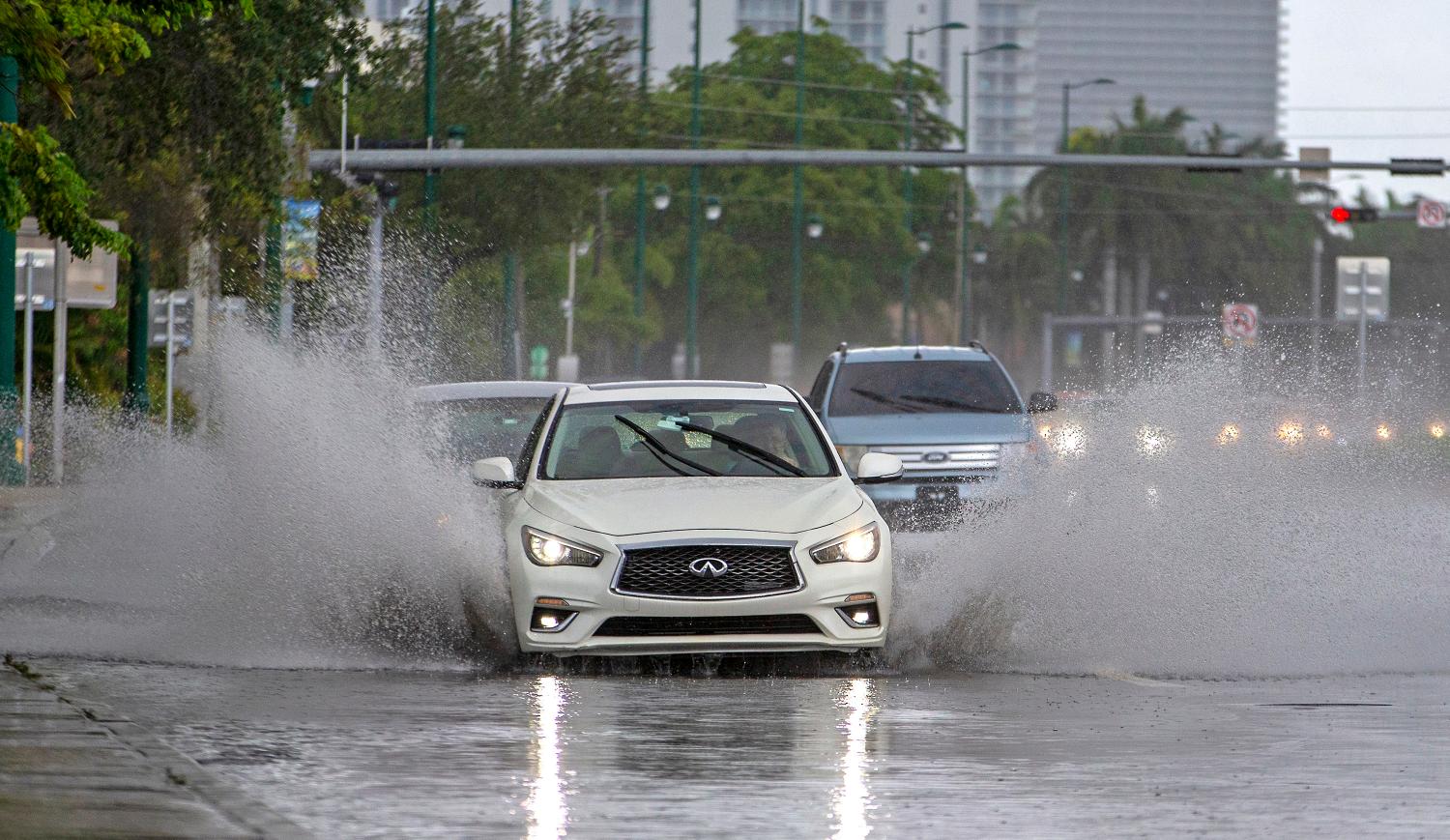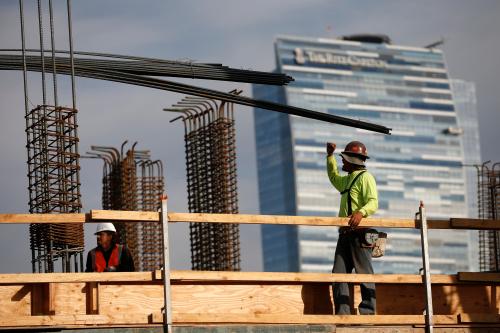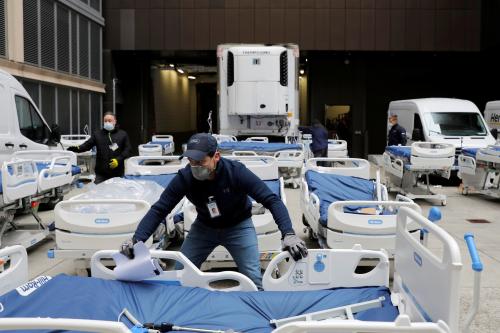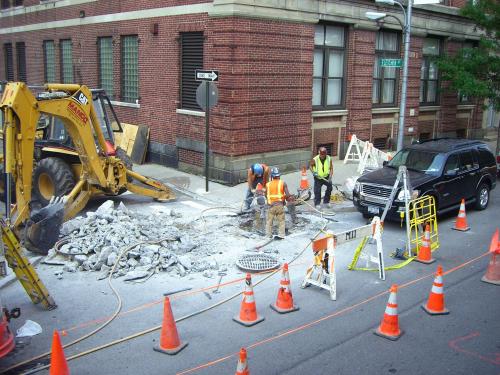Summer usually marks a time of climate uncertainty, from hurricanes along the coasts to flooding in the Midwest to droughts seemingly everywhere. Once again, climate scientists are predicting an onslaught of major storms over the next few months. If last summer was any indication, states and localities remain unprepared to plan and pay for the damage, let alone the effects of daily rainfall.
And because of the COVID-19 pandemic, this summer will be unlike any other. The virus has whipped up an economic storm of its own, leaving millions of businesses closed and workers jobless. Declines in spending and income are hitting individuals hard, while losses in sales and income tax revenue are also wreaking havoc on local and state budgets. Cities and states could experience budget deficits up to $900 billion through 2021, resulting in additional job cuts, service reductions, and project delays.
Our mounting climate and economic impacts are leading to a perfect storm, where more proactive investment in resilience is crucial to safeguard our future—and to help places and people adapt and succeed in the face of tremendous change.
We need to build back better, as many leaders in the U.S. and around the world have recently highlighted. Rising sea levels, greenhouse gases, and other global climate pressures continue to attract broader attention. But we also can’t overlook images of flooded towns in Michigan or wildfires in Arizona. National policies and investments to counter larger climate challenges matter, but so do local actions. While localities cannot single-handedly control or solve all these challenges, they are constantly exploring ways to mitigate what happens to them. And as we are seeing during the uncertain COVID-19 era, local responses matter to what we all experience every day.
Now is the moment to create a resilient platform for local growth, one that reduces uncertainty, expands economic opportunity, and ultimately adapts to an extreme climate through improvements to transportation, water, energy, and telecommunications systems. Building back better, though, is not just about physical upgrades (seawalls, permeable streets, rain gardens, etc.) that improve the performance and reliability of our built environment. It is about strengthening our local levers for action, which includes advancing policies and plans that address climate impacts on all types of households, boosting local fiscal capacity to drive new investments, and equipping workers with the skills and training to manage a cleaner, safer environment.
This brief explores the need for such a resilient platform for growth by focusing on the role of local policymakers and practitioners to drive lasting infrastructure solutions that can benefit more places and people. It first defines climate resilience and the urgency for action, before examining how places—including cities, metropolitan areas, and other localities—must expand their planning efforts and fiscal capacities to accelerate resilient infrastructure improvements. It concludes by highlighting how residents and workers must play a central part in these local efforts.
As storms get stronger, our infrastructure gets weaker
Resilient infrastructure includes transportation, water, energy, and telecommunications systems that are more flexible and responsive to a variety of climate impacts. Whether responding to acute shocks (e.g., major storms and fires) or chronic stresses (rising rainfall and temperatures), resilient infrastructure can come in many different forms and serve many different functions. Smaller-scale, decentralized green infrastructure projects (such as rain gardens) can reduce flooding, mitigate damage, and save money, while smart-grid technologies such as improved transmission lines can reduce peak energy demand, isolate power outages, and take advantage of renewable sources. Despite its varying form and function, resilient infrastructure ultimately aims to better respond to a changing climate, enabling our environment and economy to survive and thrive.
Even in the depths of a global pandemic and recession, climate change has not stopped. The atmosphere is still warming, sea levels are still rising, and storms are still brewing, despite temporary emissions dips and feel-good stories about cleaner air and water.
Our infrastructure—from roads and transit to pipes and power plants—remains vulnerable to these changes. It is easy to keep kicking the can on our infrastructure needs by delaying investments and forward-looking projects that may cost more now, but save more money over time. Instead, we rely on Band-Aid fixes: the same outdated designs, traditional technologies, and emergency repairs that keep our systems running but leave them more vulnerable to damage. Crumbling roads and bridges, brittle pipes, and aging dams are among the failing systems that federal, state, and local leaders have traditionally addressed either at the last minute or after it’s too late. These ad-hoc fixes are often politically expedient, but increasingly incapable of keeping up with the frequency and severity of our climate impacts.
Meanwhile, the frequency of high-cost climate events is rising. Since 1980, the U.S. has endured 265 climate disasters of at least $1 billion each, amounting to almost $1.8 trillion total. These not only include massive storms and flood events such as Hurricane Katrina, but also widespread droughts and wildfires. Compared to the 1980s—when there was an average of 2.9 such disasters per year, costing $17.7 billion—the 2010s saw an average of 11.9 such disasters per year, costing $80.7 billion. And these numbers do not include the smaller floods and events impacting localities every day.

Climate resilience must focus on people
It’s not just our physical infrastructure that demands greater attention and investment; people are at the center of our resilience needs.
Our climate challenges—much like our economic challenges during COVID-19—are hitting lower-income households and communities of color the hardest. Environmental justice—which includes the fair treatment and meaningful involvement of all individuals to support a clean, safe environment—has long been a concern for these same households and communities when it comes to air, water, and land quality. Air pollution, tainted water, and hazardous waste are among the environmental dangers experienced by poorer communities of color, from Los Angeles to Flint, Mich. Climate change has only exacerbated the situation for these groups, through increased greenhouse gas emissions, heat, floods, and overall destruction and displacement.
Several large climate studies, including 2018’s National Climate Assessment, have started to monitor the fallout. While many climate impacts are still evolving and can be difficult to measure at a local scale, future projections and historical trends point to greater economic vulnerability for households located in areas susceptible to flooding and other climate pressures. Job losses, lower wages, and declining home prices have resulted from disinvestment and out-migration in these areas, according to a National Bureau of Economic Research analysis looking at 90 years of natural disasters at the county level. Even after a disaster, poverty rates can increase and poorer residents can struggle to get needed assistance or rebuild their lives.
The COVID-19 era has elevated the importance of framing climate resilience and economic uncertainty based on the needs of individuals and communities. Lower-income households, including many Black and Latino or Hispanic households, are bearing the brunt of the pandemic’s impact through higher infection rates and economic damage. We must ask ourselves how our built environment continues to put these communities in harm’s way, and what types of infrastructure solutions can lead to more equitable, enduring economic growth.
The importance of local fiscal capacity
Our climate challenges are not limited to sudden catastrophic events. Escalating climate costs directly relate to how cities, metropolitan areas, and other localities are designed, financed, and overseen every day. Without proactive infrastructure planning and investment at a local level, power outages and flooding can happen more frequently, while residents are denied access to parks and other basic services. Roads, sewers, and power lines can fail regularly due to lagging maintenance and inefficient designs, leading to massive price tags for repair or replacement.
Resilient infrastructure has the potential to provide greater certainty, cost savings, a cleaner environment, and multiple other economic and social benefits, including jobs. The problem is that too few localities have the fiscal resources to make needed investments.
Although several public leaders want to accelerate resilience investment across the country—including federal action around a Green New Deal—the reality is that cash-strapped localities are still shouldering most of the risks and responsibilities. Ordinarily, state and local governments spend $342 billion on transportation and water infrastructure each year (77% of all public spending), and they own and operate most of these systems, too. Simply keeping up with ongoing operations and maintenance is challenging, and carrying out new upgrades can seem insurmountable. Over the next 20 years, coastal cities may need to spend $400 billion to construct seawalls, on top of billions of additional dollars to protect other infrastructure facilities. Other local private sector entities, such as energy utilities, are also crucial to investing in more resilience, but they also face challenges launching new system upgrades; 60% of electricity still comes from fossil fuels, and a rapid shift to lower-carbon, renewable options will require extensive political and financial buy-in.
Local leadership and local fiscal capacity are crucial in addressing climate resilience. But we need to recognize that climate impacts vary across different localities, as do the capacities to accelerate new investments.
While New Orleans, New York, and other very large metro areas have endured significant climate events over the past couple decades, the climate bill will continue to rise for almost every region. The Climate Impact Lab—a collaboration between dozens of scientists, economists, and researchers—has led one of the most comprehensive local-level assessments by projecting total climate impacts as a share of local income through the end of the 21st century.
According to the Lab, among the country’s major metro areas—the 192 markets with populations over 250,000—159 of them (83%) are projected to see higher climate costs in decades to come. However, it is midsized metro areas (with populations between 250,000 and 500,000) that are projected to have the highest climate costs as a share of their income, at 4.5%. These are places like Brownsville, Texas, Lafayette, La., and Gulfport, Miss.; regular climate impacts such as increased flooding are projected to take a bigger bite out of these local economies, including lower production and steeper job loss, as Brookings’s Mark Muro has examined.

Most concerning are those regions without the stable economic growth needed to withstand these climate impacts. Slower growth in jobs and output can lead to drops in consumer spending and industrial production, lowering income and sales tax revenues for local governments. This will reduce their fiscal capacity to pay for essential public services and carry out infrastructure projects, as we’ve seen during COVID-19.
Even before the pandemic hit, many of these midsized metro areas were struggling to generate more production, jobs, or pay compared to other markets. From 2008 to 2018, midsized metros only saw a 11.6% increase in real output, a 5.5% gain in jobs, and a 6.9% uptick in average wages—all lower than what very large and large metro areas experienced. From Atlantic City, N.J. to Corpus Christi, Texas, midsized metro areas had a weaker economic base and trajectory. So while our climate impacts are rising almost everywhere, local governments are not equally equipped to address them, especially in slower-growing midsized markets.

Differences in other underlying fiscal conditions—including revenues, expenditures, and levels of debt—also greatly influence local capacity to accelerate resilient infrastructure improvements. The Lincoln Institute of Land Policy’s Fiscally Standardized Cities (FiSC) database shows how these conditions vary across 150 cities nationally, revealing the high levels of spending and debt obligations many local governments have relative to revenues. On average, these cities each spend $2.9 billion annually and hold $3.1 billion in outstanding debt, while only generating $1.6 billion in own-source revenues (i.e., from their own taxes and fees, excluding federal and state transfers). With almost twice as much debt as own-source revenue—or even higher in several midsized cities shown below—the ability to pursue additional infrastructure projects can be a challenge.

Empowering people and places to drive resilient growth
The economic and environmental vulnerability of so many different places and people demands new solutions. Even as more cities and states reopen from COVID-19, economic pain and fiscal uncertainty are growing, and there’s no telling when the next storm, flood, or fire may hit. The long tail to any pandemic recovery combined with deep cuts to essential services and infrastructure projects will require new adaptations and collaborations. “Reopened” does not mean “recovered,” and that’s especially true when it comes to our climate resilience.
Investments in resilient infrastructure must center on people, not just projects in isolation. The uneven health and economic impacts of COVID-19, particularly on lower-income households and communities of color, has again underscored a legacy of disinvestment and disadvantage embedded in our built environment. A people-centered approach to climate resilience can help us not just recover, but better partner with nature and lead to lasting benefits.
- First, stronger community engagement and planning can help us better recognize, measure, and respond to the climate challenges facing specific people. Too often, we view climate change as an enormous and global macro force, defined by melting ice caps in the Arctic or distant natural disasters. But the reality is that the way we plan and design our cities has a direct impact on how clean, safe, affordable, and accessible our built environment can be amid a changing climate. Ongoing environmental justice concerns only further demonstrate the gaps in our built environment, especially for lower-income individuals and communities of color. Local policymakers, planners, and other practitioners need to define their shared climate goals, monitor them in light of people-centered metrics, and actualize them through new collaborations and engagements.
This planning process should involve greater coordination among city transportation departments, energy utilities, and water utilities that may have their own climate programs and priorities, and measure any infrastructure improvements not in terms of reduced pollution or flood risks, but in terms of the accessibility and affordability of more resilient options. Sidewalks, bike lanes, parks, and other public space improvements can protect our environment, improve public health, and create more equitable connections across our communities. Cities from San Diego to Chicago to Providence, R.I. have recently launched planning efforts with some of these goals spelled out, and several networks of cities have partnered on similar initiatives to look at their climate needs through an equity lens. This means setting clear, human-centric goals in new and existing plans to create a resilient built environment that works for everyone.
- Second, localities need new mechanisms to invest more in resilient infrastructure. This does not mean simply spending more money or finishing more projects—it means expanding local fiscal capacity to plan and pay for a more resilient, equitable built environment. Localities need economic and environmental certainty to thrive, and that certainty should not be limited to the largest, fastest growing metro areas with the most funding, staffing capacity, and technological prowess. An approach to help more people and places should more clearly account for the benefits of resilient infrastructure in order to achieve community (and investor) buy-in, while also having a more flexible set of financing tools to pay for upgrades and room for experimentation to scale new solutions.
Better defining the economic benefits of resilient infrastructure improvements—including increased property values and workforce development opportunities, as cities such as Camden, N.J. have realized—can shed more light on physical and social assets. With more standardized and rigorous accounting of the economic impacts, local leaders can better communicate the value of making these investments and take advantage of new financing tools, such as green bonds, climate bonds, environmental impact bonds, and community-based public-private partnerships. Although the reach and effectiveness of these new tools vary depending on the project and locality, there is untapped private capital and the potential for scaling among environmental, social, and governance (ESG) investors seeking greater environmental impact.
Local leaders in Milwaukee, Buffalo, N.Y., Atlanta, and Washington, D.C. have been among the first wave in experimenting with these new tools. Local circumstances—from flexible procurement processes to several long-standing community collaborations—allowed them to pursue such approaches to begin with. There remains a national need to further build the technical capacity of all localities to consider new ways to invest in community resilience.
- Finally, hiring, training, and retaining a skilled workforce is crucial to create a more resilient built environment. There is an opportunity to elevate the visibility and reach of careers that support greater resilience, starting with the 17 million infrastructure workers—or one out of every 10 workers nationally—who construct, operate, and maintain our transportation, water, energy, and telecommunications systems. This opportunity also centers on the 320 occupations responsible for clean energy production, energy efficiency, and environmental management. From water treatment operators to power line installers, these workers often lack visibility, despite their essential role keeping us all safe amid growing environmental threats, as we have witnessed firsthand during the COVID-19 pandemic.
Resilience-focused occupations offer more equitable wages and lower formal educational barriers to entry, and fulfill the urgent need to hire a new generation of talent given looming retirement and replacement turnover. These careers also teach in-demand skills and promote work-based learning opportunities. In other words, addressing climate resilience can elevate the economic potential of millions of prospective workers and empower many disadvantaged individuals who continue to confront systemic barriers to opportunity. Local leaders—including employers, workforce development leaders, and educational institutions—are well positioned to lead collaborations on this front. In the water sector, the Bay Area, Louisville, Ky., and several other cities have already pioneered new ways to hire more women and people of color, who have traditionally been underrepresented in these careers. What better way to improve the resilience of our built environment than to connect with those individuals who are often literally in the backyard of water plants, ports, and other infrastructure facilities?
Now is the time for greater climate resilience
The COVID-19 pandemic has left a swift and severe impact on many places, but our climate challenges continue to mount as well. Clean air, water, and land hinge on the ability of local leaders to stay ahead of their mounting infrastructure needs—a task getting harder in today’s economy and climate. With a slow-growing or declining economy, local governments may not have the durable revenue base and financial flexibility to pursue climate upgrades or even more routine infrastructure projects. Surveys indicate that up to 70% of city leaders are delaying or cancelling future projects altogether.
The pandemic’s effect on people has also highlighted the continued vulnerabilities and inequities in our built environment amid a changing climate. As utilities, transit agencies, and other infrastructure operators see dips in revenue and adjust short- and long-term plans, COVID-19 is only adding more salt to a wound that has festered for decades: inaccessible, unaffordable, and fragile infrastructure that has failed to support a clean, safe environment for millions of households. And unfortunately, it usually takes a disaster to raise our collective consciousness of this challenge.
Now more than ever, there is urgency to build greater resilience, starting with recognizing the need for local action. Measuring the scale and location of our climate impacts remain essential, but expanding local fiscal capacity to accelerate resilient infrastructure improvements is also critical. New planning approaches, financial tools, and workforce development strategies can help local leaders overcome long-standing hurdles to action and put people first. Building back better should not just be a priority during a pandemic—it can help us all adapt and succeed in an uncertain climate for decades to come.







